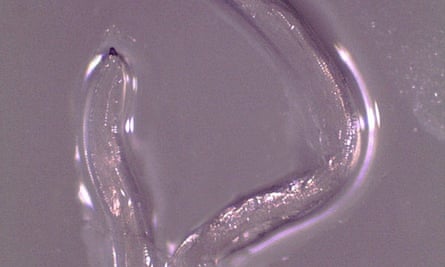After a live roundworm was found in the brain of an Australian woman, we take a look at other unusual cases of parasites turning up unexpectedly and explore how worried we should be.
Beetles
A tune by the homophonous band might give you an earworm, but an infestation of beetle larvae can cause a disease known as canthariasis.
Researchers in China reported such a case in 2016 in an eight-month-old girl with an underdeveloped immune system who had an irritable feeling. She was initially described as having worms in her stool, but further investigation revealed the creatures to be larvae of Lasioderma serricorne, commonly known as the cigar beetle.
Photograph: Tomasz Klejdysz/Alamy
The team say the beetle’s eggs could have been swallowed when the girl had contact with mud or ate oranges, which she had recently consumed.
While rare – the authors say their report is the first such case – they note such an infestation could be serious.
“This report implicates that L serricorne can infest human accidentally and cause canthariasis that may lead to severe damage to infant and older patient upon involvement of important organs of the body,” the team wrote.
Eye worms
In another stomach-turning first, a woman in Oregon was discovered to have a type of eye worm previously only seen in cattle in 2018. The worm larvae are picked up and spread by flies that feed on cow tears.
After horse riding in Gold Beach in an area where cattle are farmed, the woman, 26, experienced a week of eye irritation. The cause was discovered when she pulled a small worm from her left eye. She sought medical help, and 14 worms were subsequently removed, most of them by the patient herself.

The tiny worms, each less than a centimetre (half an inch) long, were found to be of a species called Thelazia gulosa.
Dr Richard Bradbury, the lead author of the study that reported the case and who works with the US Centers for Disease Control and Prevention’s division of parasitic diseases and malaria, said at the time that the infection was rare.
“Infections from Thelazia worms mostly happen in animals and humans are just incidental hosts,” he said. “This is incredibly interesting and I’m sure it might make some people squeamish, but it’s not something people should worry about.”
Rat lungworm
Graham McCumber, 24, ended up in hospital in Hawaii experiencing joint stiffness, fatigue and nausea after eating kale from his garden. The cause, it turned out, was rat lungworm, a parasite prevalent in south-east Asia and tropical Pacific islands.

The adult worm lives only in rodents, but its larvae can infect creatures including slugs, snails and freshwater shrimp. Should these intermediate hosts be eaten by humans, the larvae can cause angiostrongyliasis, a disease that affects the brain and spinal cord.
McCumber survived, but he was not alone. There have also been reports of people becoming infected with rat lungworm after swallowing snails for a dare. Some cases are mild but others can be fatal.
Experts say the disease can be prevented by washing and cooking vegetables, snails, crabs or shrimp thoroughly, checking vegetables for snails and slugs and avoiding eating raw vegetables where the parasite is prevalent.
Maggots
Infestation with maggots, known as myiasis, is rare in the UK and US, but it has been found in people who had travelled to tropical and subtropical areas.

Photograph: Robert Lind/Alamy
In one case, doctors removed three live botflies, each two centimetres in size, from a woman’s eye, arm and neck. The 32-year-old American had experienced a swollen eye for four weeks after visiting the Amazon rainforest.
Tapeworms
Parasites can be a real headache, as a 50-year-old man in Britain discovered when doctors found a tapeworm in his brain.
The patient had been experiencing headaches, seizures, memory flashbacks and strange smells for four years before doctors removed the worm in 2012, revealing it had burrowed from one side of his brain to the other.

The worm was discovered after MRI scans revealed an unusual cluster of rings that were found to be moving through his brain. Scientists subsequently revealed it to be a type of tapeworm known as Spirometra erinaceieuropaei, which is typically found in amphibians and crustaceans in China.
Doctors behind the discovery said the man had probably picked up the parasite when visiting China, possibly through contaminated meat or water.
Dr Hayley Bennett, who worked on the case, said at the time: “Humans are a rare and accidental host for this particular worm.”
Even more bizarre is the discovery by experts in 2015 that when tapeworms get what looks like cancer, their human host can develop tumours.
The discovery was made after scientists in the US were asked to investigate biopsies from lung tumours and lymph nodes taken from a 41-year-old man who had HIV. The team found cancer-like cells, but revealed they were not human. Instead they were from a common type of tapeworm called Hymenolepis nana.
Dr Peter Olson of the Natural History Museum in London, who worked on the case, said such situations were very rare and only found in patients who are heavily immunocompromised.

